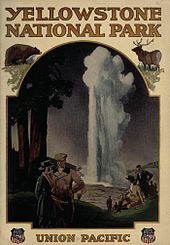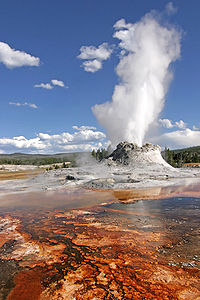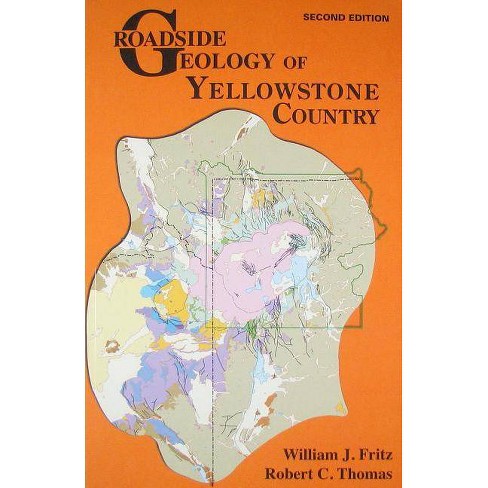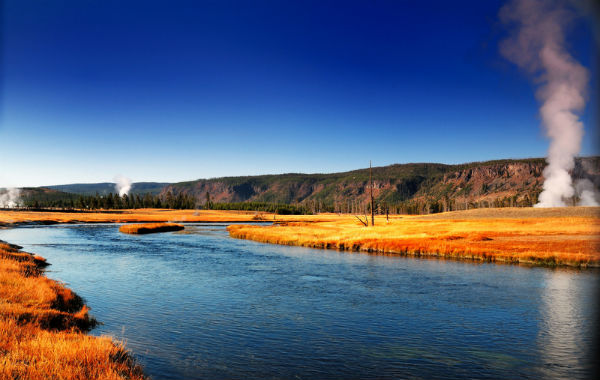Yellowstone’s vegetation is composed primarily of typical Rocky Mountain species. It is also influenced by flora of the Great Plains to the east and the Intermountain to the west. The exact plant community present in any area of the park reflects a complex interaction between many factors including the regional flora, the climate, the topography, and the local substrates/soils.
The vegetation of the park is interrelated with the geology of the park. The region’s caldera explosions catastrophically destroyed vegetation. In addition, glaciers significantly altered the region. Today, the roughly 1,150 native species of flowering plants in the park represent the species able to either persist in the area or recolonize after glaciers, lava flows, and other major disturbances.
Unlike southwestern Wyoming or central Idaho, the Greater Yellowstone region has few endemic vascular plant species, primarily in the eastern portion of the Absaroka Mountains outside of Yellowstone. Within Yellowstone, only three endemics occur, Yellowstone sand verbena (Abronia ammophila), Ross’ bentgrass (Agrostis rossiae), and Yellowstone sulfur wild buckwheat (Eriogonum umbellatum var. cladophorum).
Montane Forests
Forests cover roughly 80 percent of the park. Miles and miles of lodgepole pine forest characterize the park, especially within the Yellowstone Caldera. Extensive areas of forest dominated by subalpine fir and Engelmann spruce are also present, especially in areas such as the Absaroka Range that are underlain by andesites. These species can also be common in the understory where the canopy is entirely composed of lodgepole pine.
Through time, in the absence of fire and in non-rhyolitic soil, subalpine fir and Engelmann spruce can replace the lodgepole pine, leading to a canopy dominated by these species. In rhyolitic soils, which are poor in nutrients needed by fir and spruce, lodgepole pine remains dominant. At higher elevations such as the Absaroka Mountains and the Washburn Range, whitebark pine becomes a significant component of the forest. In the upper subalpine zone, whitebark pine, Engelmann spruce, and subalpine fir often grow in small areas separated by subalpine meadows. Wind and dessication cause distorted forms known as krumholtz where most of the ‘tree’ is protected below snow.
Douglas-fir Forests
Douglas-fir forests occur at lower elevations, especially in the northern portion of the park. The thick bark of Douglas-fir trees allows them to tolerate low-intensity fire.
Some of the trees in these forests are several hundred years old and show fire scars from a succession of low intensity ground fires. In contrast, lodgepole pine trees have very thin bark and can be killed by ground fires.
Lodgepole pine forests
- Dominate more than 80% of the total park forested area.
- Can be seral (developing) or climax.
- Climax forests underlain by rhyolite.
Douglas-fir forests
- Associated with the Lamar, Yellowstone, and Madison river drainages below 7,600 feet.
- Often less than 20 inches annual precipitation.
- More frequent historic fire interval (25–60 year) than other forest types in the park.
Spruce-fir forests
- Engelmann spruce and subalpine fir dominate older forests.
- Usually found on moist and/or fertile substrates.
- Climax forests underlain by andesitic soils.
Whitebark pine forests
- Major overstory component above 8,400 feet.
- Major understory component of lodgepole dominated forests from 7,000 to 8,400 feet.
- Seeds are ecologically important food for a variety of wildlife species.
Non-forested areas
- Includes grasslands, sagebrush, alpine meadows, talus, and hydrothermal environments.
- Encompasses the moisture spectrum from dry sagebrush shrublands to wet alpine meadows.
- Provides the winter and summer forage base for ungulates.
Other types not shown on map
- Aspen—found in small clones interspersed among the sagebrush/forest ecotone (transition zone) along the Yellowstone, Madison, and Snake river drainages.
- Wetland—includes various grass, forb, rush, sedge, and woody species.
- Riparian—typically streamside vegetation includes cottonwoods, willows, and various deciduous shrubs.
Major Types of Trees in Yellowstone
Lodgepole Pine Pinus contorta
- Most common tree in park
- Needles in groups of twos
- May have serotinous cones
- Up to 75 feet tall
Limber Pine P. flexilis
- Needles in groups of five
- Young branches are flexible
- Up to 75 feet tall
- Often on calcium-rich soil
Whitebark Pine P. albicaulis
- Grows above 7000 feet
- Needles in groups of five
- Purple-brown cones produce important food for squirrels, bears, Clark’s nutcrackers
- Up to 75 feet tall
Engelmann Spruce Picea engelmannii
- Often along creeks, or wet areas
- Sharp, square needles grow singly
- Cones hang down and remain intact, with no bract between scales
- Up to 100 feet tall
Subalpine Fir Abies lasiocarpa
- Only true fir in the park
- Blunt, flat needles
- Cones grow upright, disintegrate on tree
- Up to 100 feet tall
Douglas-Fir Pseudotsuga menziesii
- Resembles the fir and the hemlock, hence its generic name Pseudotsuga, which means “false hemlock”
- Cones hang down and remain intact, with 3-pronged bract between scales
- Thick bark resists fires
- Up to 100 feet tall
Rocky Mountain Juniper Juniperus scopulorum
- Needles scale-like
- Cones are small and fleshy
- Up to 30 feet tall
Cottonwood Populus spp.
- Several species and hybrids
- Up to 75 feet tall
- Thick, furrowed bark
- Seeds with tangled hairs—the “cotton”— dispersed by wind
Quaking Aspen Populus tremuloides
- Sedimentary soils in damp areas
- Flexible leaf petioles quake and shiver in the breeze
- Trunks often rough and black due, in part, to browsing by elk and other animals
- Reproduces by cloning (most often), and by seeds (related to fire)
The Lodgepole Pine
The lodgepole pine (Pinus contorta) is by far the most common tree in Yellowstone. Early botanical explorers first encountered the species along the West Coast where it is often contorted into a twisted tree by the wind, and thus named it Pinus contorta var. contorta. The Rocky Mountain variety, which grows very straight, is Pinus contorta var. latifolia. Various Native American tribes used this tree to make the frames of their tipis or lodges, hence the name “lodgepole” pine.
Typically, lodgepole pine in Yellowstone is seldom more than 75 feet tall. The species is shade intolerant; any branches left in the shade below the canopy will wither and fall off the tree. Lodgepoles growing by themselves will often have branches all the way to the base of the trunk because sunlight can reach the whole tree.
Lodgepoles are the only pine in Yellowstone whose needles grow in groups of two. The bark is typically somewhat brown to yellowish, but a grayish-black fungus often grows on the shady parts of the bark, giving the tree a dark cast.

Lodgepole Pines
Like all conifers, lodgepole pines have both male and female cones. The male cones produce huge quantities of yellow pollen in June and July. This yellow pollen is often seen in pools of rainwater around the park or at the edges of lakes and ponds. The lodgepole’s female cone takes two years to mature. In the first summer, the cones look like tiny, ruby-red miniature cones out near the end of the branches. The next year, after fertilization, the cone starts rapidly growing and soon becomes a conspicuous green. The female cones either open at maturity releasing the seeds, or remain closed until subjected to high heat such as one would see in a forest fire – a condition called serotiny. These cones remain closed and hanging on the tree for years until the right conditions allow them to open. Within a short period of time after the tree flashes into flame, the cones open up and release seeds over the blackened area, effectively dispersing seeds after forest fires. Trees without serotinous cones (like Engelmann spruce, subalpine fir, and Douglas-fir) must rely on wind, animals, or other agents to carry seeds into recently burned areas.
Lodgepole pines prefer a slightly acid soil, and will grow quickly in mineral soils disturbed by fire or by humans (such as a road cut). Their roots spread out sideways and do not extend deeply—an advantage in Yellowstone where the topsoil is only about 6 to 12 inches deep, but a disadvantage in high winds. Lodgepole pines are vulnerable in windstorms, especially individuals that are isolated or in the open.
Besides reseeding effectively after disturbance, lodgepole pines can grow in conditions ranging from very wet ground to very poor soil prevalent within the Yellowstone Caldera. This flexibility allows the species to occur in habitat that otherwise would not be forested.
Because lodgepole pines are dependent on sunny situations for seedling establishment and survival, the trees do not reproduce well until the canopy opens up significantly. In the Yellowstone region, this allows the lodgepole pine forest to be replaced by shade-loving seedlings of subalpine fir and Engelmann spruce where the soil is well developed enough to support either of these species. In areas of nutrient poor soil, where Engelmann spruce and subalpine fir struggle, lodgepole pines will eventually be replaced by more lodgepole pine trees as the forest finally opens enough to allow young lodgepoles to become established.
Insects and Fungus Threaten the Trees of Yellowstone
The conifer trees of Yellowstone face six major insect and fungal threats. The fungus is an exotic species, but the insects are native to this ecosystem. They have been present and active in cycles, probably for centuries. A scientist studying lake cores from the park has found some of their insect remains in the cores, indicating their presence even millions of years ago. However, in the last ten years, all five insects have been extremely active, which may be due to the effects of climate change.
The beetles damage trees in similar ways: their larvae and adults consume the inner bark. If the tree is girdled, it dies.
- Mountain pine beetle (Dendroctonus ponderosae) Affects whitebark, lodgepole, and limber pine. The tree defends itself by increasing resin (pitch) production, which can “pitch out” the insect from the tree and seal the entrance to others. Look for globs of resin, often mixed with wood borings, on the bark. Adults emerge in mid-summer.
- Spruce beetle (D. rufipennis) Affects Englemann spruce, rarely lodgepole pine. Larvae feed for two years. Look for reddish dust on the bark and at the base of the tree in early summer.
- Douglas-fir beetle (D. pseudotsugae) Affects Douglas-fir. Larvae also consume outer bark.
- Western balsam bark beetle (Dryocoetes confusus) Affects subalpine fir.
- Western spruce budworm (Choristoneura occidentalis) Affects Douglas-fir, true firs, spruce. Larvae defoliate trees and can destroy cones and seeds. Look for clumps of chewed needles on branch tips.
- Blister rust is a disease caused by a fungus, Cronartium ribicola. Affects whitebark and limber pines. The disease impacts the tree’s ability to transport nutrients and produce cones, and generally kills the tree. Look for cankers (lesions) on the bark.


 Archaeology
Archaeology History of Yellowstone
History of Yellowstone Thermal Features
Thermal Features Geology
Geology Rivers, Streams, & Lakes
Rivers, Streams, & Lakes